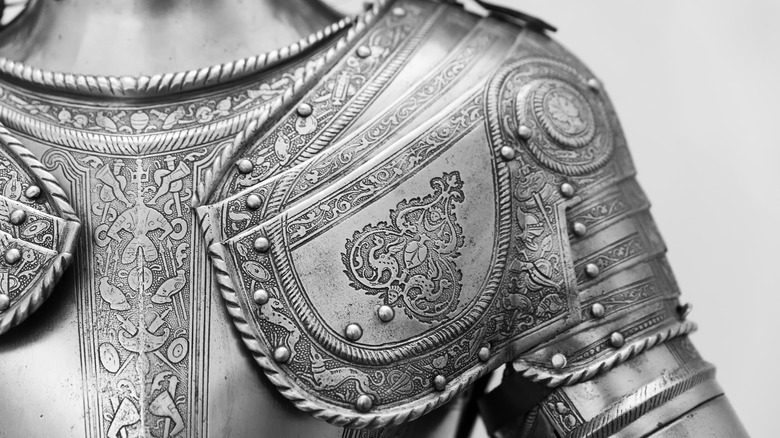How A Pizza Delivery Led To The Invention Of The Modern Bulletproof Vest
What could be better than pizza delivered straight to your door? All that oozing cheese, box-buckling oil, and heaped ingredients emitting rich scents. And bonus: On the way to your house all that oozing cheese might cascade to one half of a then-lopsided lactic bulge. Just don't take it out on the pizza delivery person. Those folks have got to put up with a whole lot of jerks lurking behind strange walls in various states of undress, tipless nights from ungrateful pie-buyers, and even automatic weapons shoved in their face.
Think we're kidding? Tell it to Richard C. Davis, Marine and World War II veteran turned pizza shop owner. As Pin Shoot recounts, Davis was out making the delivery rounds back in 1969 in Detroit, Michigan when he rolled up to a completely dark house. When he asked, "Did you guys order a pizza?" a voice replied, "Yeah, bring it around back." And because Davis apparently always packed heat as well as steam, he slid out a .22 revolver on the way just in case.
Lo and behold, Davis found "three men standing in a 'V' formation" in the back, with the center guy "pointing a nickel plated automatic right at his face." In a scene straight from the badass hall of fame, Davis shot the first dude in the jaw from under the pizza boxes. Four out of his six shots hit, and although he was wounded, Davis lived. Fast forward several years and Davis fashioned the world's first Kevlar vest.
Pepperoni with a side of flak jacket
Make no mistake: Richard C. Davis didn't make it out unharmed on that fateful 1969 night. As Pin Shoot recounts, he was shot twice. One bullet lodged itself in "the back of his thigh," and the other near his temple after his glasses deflected it.
After the attack, two of his three would-be muggers lay badly injured. Meanwhile, Davis himself laid in his hospital bed mulling over mortality and similar dangers faced by people with jobs far more dangerous than a simple pizza delivery person. After all, not all pizza delivery people are ex-Marines. If police officers could wear some kind of armor, Davis reckoned, like a magic shirt made of bullet-deflecting material, then they'd be safer than not. But what could possibly stop a bullet, besides fictions like Superman's outstretched palm?
By that time, flak jackets (pictured above) had been worn by Vietnam-era soldiers to stop small arms fire, but there was no civilian equivalent used by law enforcement. Besides, as Science Direct says, flak jackets were "heavy," "bulky," and "provided limited protection from high-speed projectiles," including tiny shrapnel that whizzes around a battlefield. Flak jackets contained steel plates — not the easiest thing to wear — bound together by other materials. Davis started playing around with some of those interstitial materials, particularly "high tenacity nylon," a lightweight and flexible material suitable for shirts and vests.
Millennia of metal armor
The reader might be wondering why it took all the way until 1969 for anyone to start developing what we now generally call a "bulletproof vest." Perhaps the inherent sensibility of the flak jacket is partially to blame. After all, how did knights of yore deflect sword blows or arrowheads? Armor, of course. In the battle of thick metal shielding vs. small metal objects, thick wins.
Whether metal-studded leather, chain mail, scale mail, full plate, or whatever else, body armor has protected fighting forces for thousands of years. Granted, weapons like javelin-hurling ballistae would have punctured anything wearable by an individual person. Better armor also means that the other side will turn to developing weapons that pierce armor. And nothing — nothing — will protect a post-medieval soldier from cannon fire à la the U.S. Civil War. But on city streets, common criminals aren't dragging around cannons with them; they're packing small firearms. And small firearms, at least, can be blocked by personal body armor.
This is why Richard C. Davis turned his attention to a practical, on-the-street method of life preservation. As Pin Shoot says, he was also guided by a rash of attacks made against law enforcement officers in the late 1960s and early '70s using cheap handguns described by the umbrella term "Saturday Night Specials." Davis' brilliance, though, came from devising a counterintuitive, elegant solution beyond thick metal shielding, one that incorporated an unlikely source of protection: fabric.
Kevlar, the wonder fabric
Because all successful inventions depend on timing and technology as much as imagination and need, we've got to give credit to the person who engineered the fabric that Davis used in his vests: Stephanie Kwolek. Kwolek worked for DuPont during the 1960s and '70s, and counts among her patents a trademarked "heat-resistant para-aramid synthetic fiber" that most of us today recognize by name: Kevlar. As Earth.com explains, Kevlar was originally developed in 1965 to replace "steel in racing tires." Beginning as a rope or sheet, it can be shaped a multitude of ways and incorporated into countless products.
As DuPont says, Kevlar is composed of links of interchain hydrogen bonds perfect for Davis' vests. As a study in Biophysical Journal published on the National Library of Medicine reports, such bonds "raise the stiffness" of molecular chains; this is actually why certain plants are stiffer than others. In the end, this composition grants Kevlar a "tensile strength ten times greater than steel on an equal weight basis." Its fibers are spun so tightly that they spread the shock of impact around and practically "catch" a projectile.
We Are the Mighty says that Davis used some Kevlar to prototype and iterate on his bulletproof vest design. With the paced, reasoned determination of an engineer, he eventually fashioned a vest with one rectangle in front, another in back, and straps around the sides and shoulders, per Pin Shoot. It stopped .22 caliber pistols, .25s, .32s, .357 magnums, and .38s.
Self-pointed target practice
From there, Marine-turned-pizza-delivery-person Richard C. Davis had to surmount another hurdle, possibly far more insidious even than street assassins: marketing. Law enforcement didn't really take to Davis' thin fabric vest, perhaps preferring instead some chunky, tank-like body armor. Many potential customers disregarded him outright out of "disbelief or machismo," as Pin Shoot says. For others he strapped his prototype to a block of clay and shot it. It stopped bullets, but left the clay dented. Buyers were afraid bullets would crack a wearer's rib, pop a heart, or splay bones chips through the chest. In the end, Davis knew nothing but a demonstration using a live person would do. And so, he volunteered himself.
In 1972 at the Walled Lake, Michigan Police Department shooting range, Davis pointed a .38 directly at his heart, mere inches away. In a line that deserves to be included in every heroic action movie ever, he said, "If this works it could save a thousand men in the next ten years. If it doesn't, they will die as I will." He pulled the trigger, the shot went off, and he then took aim at some nearby bowling pins — you can watch the whole demonstration on YouTube. Blam, blam, blam, the pins went down. "It stings," he said, and pulled up his shirt to show that the bullet never touched his body. In an interview with the Smithsonian Channel (posted on YouTube), Davis says he ended up shooting himself over 200 times.
Thousands of lives saved
Davis went on to found Second Chance Body Armor Company in 1970. He expanded on his vest's original design to develop whole lines of body armor, including improvements such waterproof covers in 1993, per Pitchbook. Pin Shoot says that Davis received "numerous awards and accolades" during his 32 years as head of Second Chance, and in the early days traveled around the U.S. to give live demonstrations to convince buyers about his invention. In 2005 Armor Holdings, Inc. bought Second Chance for $45 million in cash following a debacle that involved Second Chance selling defective vests under the "Zylon" trademark, as Corrections 1 and the United States Department of Justice recount. The incident led to Davis retiring in 2004, but not before he'd made an impact potent enough to resonate all the way to the present.
At present, there are countless body armor companies in the U.S. and beyond, as sites like Body Armor News.com show. Thomas lists top revenue earners like White Horse Research and Development, Inc. founded in 1988, which earns between $10 million and $24.9 million annually. Companies specialize in everything from "ballistic blankets" to "trauma plates," "identification placards" to "aerospace pyrotechnic devices," in medical, military, automotive, industrial, governmental, aeronautic sectors, and more. But it's important to remember that all of it, head to toe, started with a single pizza delivery guy — and crack shot marksman — who almost got mugged in Detroit back in 1969.





